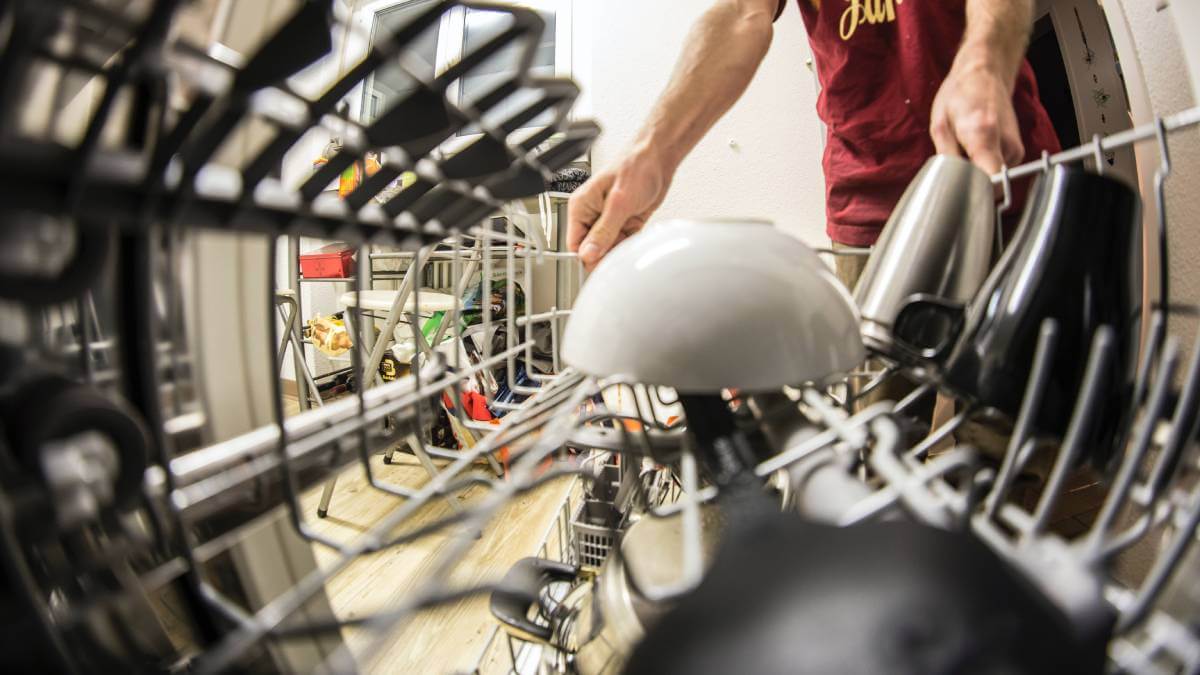Have you ever loaded the dishwasher – only to find your partner redoing it ‘properly’ later?
What loading it ‘properly’ actually means can be a bone of contention in many households, but getting the job done right will help ensure dishes really do come out clean, as well as saving time and energy.
As the experts at Finish Dishwasher Tablets point out: “Dishwashers come in all shapes and sizes to cater to everybody’s needs and kitchens, but generally there are a few rules to follow when it comes to filling your dishwasher. Thinking about how you stack your dishwasher can ultimately make doing the dishes that little bit easier.”
So now’s your chance to (hopefully) nip those loading quarrels in the bud, by becoming your home’s dishwasher authority. Here are 10 dishwasher ‘rules’, including some top tips from Finish along with a few of our own.
1. Check items can actually go in there
Be sure your dishes, and other items, are ‘dishwasher safe’ before you load them. Most items can go in the dishwasher, but the Finish experts say some non-stick surfaces could become less effective after a spin in the dishwasher, and it’s not a good idea to put lead crystal glasses in either – they should be washed by hand.
Read: Soap up to keep your dishwasher in top condition
2. No need to pre-wash
Just scrape leftover food off dishes, there’s no need to pre-wash them. Anything thick and caked on should be removed, but smaller particles like grains of rice may come off in the dishwasher. However, wiping off with a cloth will lead to much better results. Let experience be your guide, and if dishes aren’t coming out clean, try pre-rinsing in hot water to loosen food before it hardens onto them. Proteins such as eggs and cheese, cooked or baked-on foods, and starches that have dried onto the dish often require extra attention.

3. Stack from the back
Start stacking from the back of the dishwasher, so you don’t have to keep rearranging the dishes every time you want to slot another one in.
4. Size matters
The Finish experts recommend putting larger plates at the back of the dishwasher and loading in size order. Put pots and pans open-side down in the bottom section.
Read: Kitchen cleaning tips that save time and money
5. Take care with glasses
When putting glasses in the dishwasher, make sure they aren’t touching each other, because the water pressure could make them bang against each other and break. Smaller glasses should go on the top rack and taller glasses on the bottom. If you have a plastic, mesh-like piece on the top rack, use it to grip wine-glass stems to stop them from getting scratched or cracked.
6. Put plastic on top
Put plastic items on the top rack, as the heating element in most dishwashers is on the bottom, and if plastic items are placed near it they could melt. Also, make sure they’re secure so they don’t flip and fill with water.
7. Lean the dishes
If you stack things slightly on their side, it not only ensures the detergent reaches everything, but also helps the water drain away effectively. So lean dishes inwards and downwards if you can. “There’s nothing more annoying than picking up something quickly, thinking it’s dry and then throwing some water at yourself,” says one of the Finish pros.
8. Don’t overcrowd
While you should always make sure the dishwasher’s full, so you’re getting value for money (and being energy-efficient) with each wash, it’s never good to overcrowd it. This will lead to items not being properly cleaned if the water can’t reach them, and food can get trapped on your dishes.

9. Don’t stack things on top of each other
Dishes that are stacked on top of each other won’t be entirely secure and could be dislodged by the pressure of the water, leading to breakages. Stack bowls neatly at an angle, so the detergent can get inside them and so they’ll drain. But don’t let them take up too much room.
Read: Don’t put these items in the dishwasher
10. Safety first
Either wash sharp knives by hand, or put them face down in the cutlery rack to avoid accidents. Put all the other cutlery handle-down, separating pieces as much as possible. Bigger pieces of cutlery, like serving spoons, should be laid down on the top shelf, facing down so water doesn’t collect in them.
Do you follow these rules or do you have your own way of stacking the dishwasher? Why not share your tips in the comments section below?
– With PA


I never put plastics/pots nor pans into my dishwasher …… particularly after ruining a perfectly good 1/4″ inch thick small metal frying pan in one.
We don’t have a tray for our cutlery.Our Bosch machine has a basket, and the fork tines go down, not up , same as with knife handles. You have just cleaned and virtually sterilised the cutlery, so you don’t want to be picking up forks by their tines with your unwashed fingers, (what were you doing before emptying the washer ?) same as with knives. We always put the handles up, and that goes for spoons as well. !